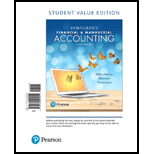
Horngren's Financial & Managerial Accounting, Student Value Edition (6th Edition)
6th Edition
ISBN: 9780134491554
Author: Tracie L. Miller-Nobles, Brenda L. Mattison, Ella Mae Matsumura
Publisher: PEARSON
expand_more
expand_more
format_list_bulleted
Question
Chapter 12, Problem 21RQ
To determine
Bonds Payable: Bonds payable are referred to long-term debts of the business, issued to various lenders known as bondholders, generally in multiples of $1,000 per bond, to raise fund for financing the operations.
Discount on bonds payable: It occurs when the bonds are issued at a low price than the face value.
Premium on bonds payable: It occurs when the bonds are issued at a high price than the face value.
To Explain: Effective-interest amortization method, in regard to a bond discount or premium.
Expert Solution & Answer
Want to see the full answer?
Check out a sample textbook solution
Students have asked these similar questions
Find Cost account answer
Overhead variance?
Find Cost account answer
Chapter 12 Solutions
Horngren's Financial & Managerial Accounting, Student Value Edition (6th Edition)
Ch. 12 - Prob. 1QCCh. 12 - Daniels's bonds payable carry a stated interest...Ch. 12 - A bond that matures in installments at regular...Ch. 12 - Prob. 4QCCh. 12 - Nicholas Smith Fitness Gym has 700,000 of 20-year...Ch. 12 - Prob. 6QCCh. 12 - Prob. 7QCCh. 12 - The debt to equity ratio is calculated as a. Total...Ch. 12 - Mike Gordon wishes to have 80,000 in five years....Ch. 12 - Prob. 10QC
Ch. 12 - Prob. 1RQCh. 12 - What is an amortization schedule?Ch. 12 - What is a mortgage payable?Ch. 12 - What is a bond payable?Ch. 12 - What is the difference between the stated interest...Ch. 12 - When does a discount on bonds payable occur?Ch. 12 - When does a premium on bonds payable occur?Ch. 12 - When a bond is issued, what is its present value?Ch. 12 - Why would a company choose to issue bonds instead...Ch. 12 - Prob. 10RQCh. 12 - Prob. 11RQCh. 12 - Prob. 12RQCh. 12 - Prob. 13RQCh. 12 - Prob. 14RQCh. 12 - Prob. 15RQCh. 12 - Prob. 16RQCh. 12 - Prob. 17RQCh. 12 - Prob. 18RQCh. 12 - Prob. 19RQCh. 12 - Prob. 20RQCh. 12 - Prob. 21RQCh. 12 - Prob. 12.1SECh. 12 - Prob. 12.2SECh. 12 - Determining bond prices Bond prices depend on the...Ch. 12 - Prob. 12.4SECh. 12 - Prob. 12.5SECh. 12 - S12-6 Journalizing bond transactions
Power Company...Ch. 12 - S12-7 Journalizing bond transactions
Owen Company...Ch. 12 - S12-8 Journalizing bond transactions
Wilkes Mutual...Ch. 12 - Prob. 12.9SECh. 12 - Prob. 12.10SECh. 12 - Prob. 12.11SECh. 12 - Prob. 12.12SECh. 12 - Prob. 12.13SECh. 12 - Prob. 12.14SECh. 12 - Prob. 12.15SECh. 12 - Prob. 12.16SECh. 12 - Prob. 12.17SECh. 12 - Prob. 12.18ECh. 12 - E12-19 Preparing an amortization schedule and...Ch. 12 - E12-20 Analyzing alternative plans to raise...Ch. 12 - E12-21 Determining bond prices and interest...Ch. 12 - E12-22 Journalizing bond issuance and interest...Ch. 12 - Prob. 12.23ECh. 12 - Prob. 12.24ECh. 12 - E12-25 Journalizing bond issuance and interest...Ch. 12 - Prob. 12.26ECh. 12 - Prob. 12.27ECh. 12 - Prob. 12.28ECh. 12 - Prob. 12.29ECh. 12 - Prob. 12.30ECh. 12 - Prob. 12.31ECh. 12 - Prob. 12.32APCh. 12 - P12-33A Analyzing, journalizing, and reporting...Ch. 12 - Prob. 12.34APCh. 12 - Prob. 12.35APCh. 12 - Prob. 12.36APCh. 12 - Prob. 12.37APCh. 12 - P12AB-38A Determining the present value of bonds...Ch. 12 - Prob. 12.39BPCh. 12 - Prob. 12.40BPCh. 12 - Prob. 12.41BPCh. 12 - Prob. 12.42BPCh. 12 - Prob. 12.43BPCh. 12 - Prob. 12.44BPCh. 12 - Prob. 12.45BPCh. 12 - Prob. 47CPCh. 12 - Prob. 12.1TICh. 12 - The following questions are not related....Ch. 12 - Raffle's Kids, a nonprofit organization that...Ch. 12 - Bill and Edna had been married two years and had...Ch. 12 - Prob. 12.1FSC
Knowledge Booster
Learn more about
Need a deep-dive on the concept behind this application? Look no further. Learn more about this topic, accounting and related others by exploring similar questions and additional content below.Similar questions
- Hurwitz, LLC sells a parcel of waterfront land and a residential condo building with an adjusted tax basis of $100,000 and 50,000, respectively for $500,000. The original purchase price Hurwitz, LLC allocated to the building was $600,000. Hurwitz LLC has deducted $550,000 in depreciation expense. Hurwitz, LLC's realized gain on this transaction is $350,000. If Hurwitz LLC takes back a note as part of the proceeds, what is Hurwitz LLC's gross profit percentage? A. 83.33% B. 71.43% C. 70% D. 50% E. 30%arrow_forwardprovide answer of this Financial accounting questionarrow_forwardhi expert given answer General accounting questionarrow_forward
arrow_back_ios
SEE MORE QUESTIONS
arrow_forward_ios
Recommended textbooks for you
- Principles of Accounting Volume 1AccountingISBN:9781947172685Author:OpenStaxPublisher:OpenStax College
 Intermediate Accounting: Reporting And AnalysisAccountingISBN:9781337788281Author:James M. Wahlen, Jefferson P. Jones, Donald PagachPublisher:Cengage Learning
Intermediate Accounting: Reporting And AnalysisAccountingISBN:9781337788281Author:James M. Wahlen, Jefferson P. Jones, Donald PagachPublisher:Cengage Learning College Accounting, Chapters 1-27AccountingISBN:9781337794756Author:HEINTZ, James A.Publisher:Cengage Learning,
College Accounting, Chapters 1-27AccountingISBN:9781337794756Author:HEINTZ, James A.Publisher:Cengage Learning,  Cornerstones of Financial AccountingAccountingISBN:9781337690881Author:Jay Rich, Jeff JonesPublisher:Cengage Learning
Cornerstones of Financial AccountingAccountingISBN:9781337690881Author:Jay Rich, Jeff JonesPublisher:Cengage Learning

Principles of Accounting Volume 1
Accounting
ISBN:9781947172685
Author:OpenStax
Publisher:OpenStax College

Intermediate Accounting: Reporting And Analysis
Accounting
ISBN:9781337788281
Author:James M. Wahlen, Jefferson P. Jones, Donald Pagach
Publisher:Cengage Learning

College Accounting, Chapters 1-27
Accounting
ISBN:9781337794756
Author:HEINTZ, James A.
Publisher:Cengage Learning,

Cornerstones of Financial Accounting
Accounting
ISBN:9781337690881
Author:Jay Rich, Jeff Jones
Publisher:Cengage Learning
What is Fund Accounting?; Author: Aplos;https://www.youtube.com/watch?v=W5D5Dr0j9j4;License: Standard Youtube License